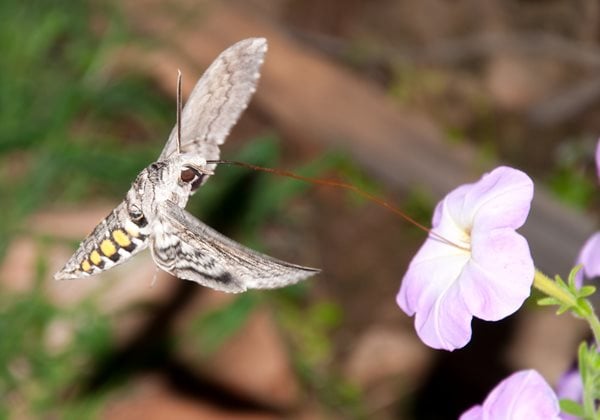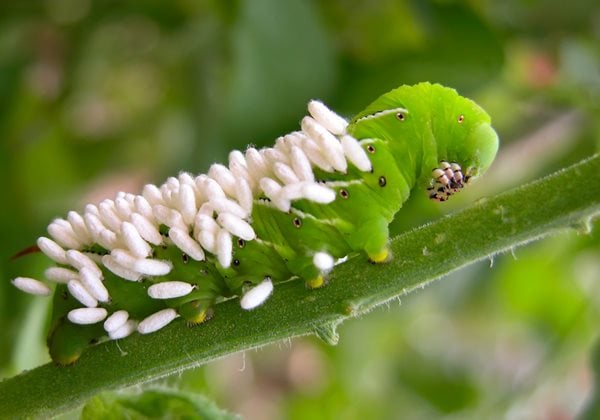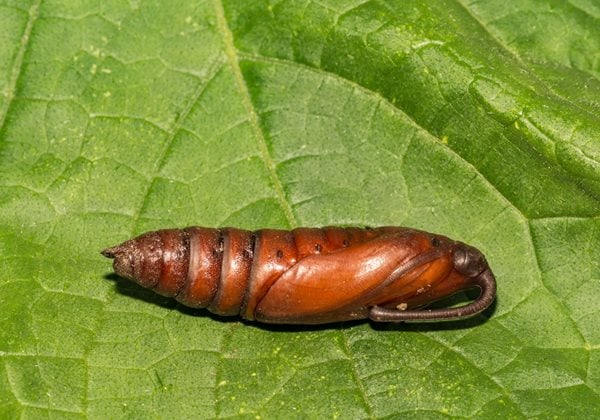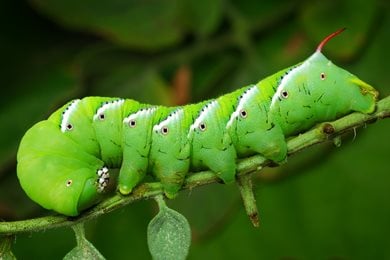6 Ways to Prevent and Get Rid of Tomato Hornworms
Don’t let these voracious caterpillars chew up your tomato plants. Use these natural control methods to keep them out of your garden.You’ve waited all summer for that first luscious tomato to ripen only to discover that, almost overnight, something has been feasting on your tomato plants, stripping the stems bare and chomping holes in your nearly ripe fruit. The culprit? Most likely it’s the tomato hornworm (Manduca quinquemaculata), a plump, green caterpillar named for the threatening but harmless “horn” protruding from its tail.
What makes the tomato hornworm such a menacing garden pest is its ability to defoliate tomato plants in days. Although it prefers to munch on tomatoes, it will also happily feed on potatoes, eggplant, peppers, tobacco, and other plants in the nightshade family (Solanaceae).
The good news is that you can eradicate tomato hornworms, without resorting to chemical insecticides, by using a variety of natural control methods. Learning how to recognize the early signs of a hornworm infestation can also help you prevent these destructive creepy-crawlers from getting out of hand.
1. INSPECT YOUR PLANTS REGULARLY
Tomato hornworms are typically easy to control in the garden if you regularly monitor your plants for the presence of the caterpillars as well as the adult moths (called five-spotted hawk moths) that bring them into being.
Although the caterpillars are large (typically 3 to 5 inches long), they are well-camouflaged and blend in almost invisibly with the color of the foliage. They typically become active in early to midsummer, just as tomato plants are reaching full size. You can identify them by the V-shaped white markings on each side of their bodies and their distinctive black horns. But often the first clues that hornworms are present are chewing damage and dark green droppings (frass) deposited on the leaves.
Watch this short video from Erin, The Impatient Gardener, to see how to look for them at night.
Adult moths can be recognized by their mottled gray-brown color, impressive 4- to 5-inch wingspan, and yellow spots on each side of their abdomens. You’ll usually see them after dusk, hovering like nocturnal hummingbirds to sip nectar from flowers. In late spring, be on the lookout for the female moth’s small green eggs, which she will lay on the host plant’s leaves. Once the hornworms hatch, your plants are at the mercy of their insatiable appetites for up to 4 weeks.

Five-spotted hawk moth. Photo by: Sari ONeal / Shutterstock
Tip: The tomato hornworm is sometimes confused with the tobacco hornworm (Manduca sexta), a close cousin commonly found in the southeastern U.S. that also targets plants in the nightshade family. Although these caterpillars are similar in appearance, the horn of the tobacco hornworm is reddish in color and the white markings on the body are diagonal rather than V-shaped. No matter which type of hornworm you’re dealing with, the damage they can do to your plants is equally devastating.
2. PICK OFF THE CATERPILLARS BY HAND
Once you spot tomato hornworms, often the best way to deal with them, especially if their numbers are small, is to pick them off your plants by hand and drown them in a pail of soapy water. Hornworms do not bite or sting, but if you are squeamish, wear a pair of garden gloves for the task.
Because tomato hornworms are such rabid eaters, it’s a good idea to inspect for them daily and pluck them off as soon as possible. The best time to check for hornworms is during the evening, when they come out in the open to feed. If you shine a bright flashlight on your plants, these elusive critters will be easier to catch sight of.
3. ATTRACT BRACONID WASPS TO YOUR GARDEN

Tomato hornworm with braconid wasp eggs. Photo by: Stephen Bonk / Shutterstock
A natural enemy of the tomato hornworm is the braconid wasp (Cotesia congregatus), a small, non-stinging parasitic wasp that deposits its eggs just under the skin of soft-bodied caterpillars. The eggs hatch and the larvae feed on the hornworm until they are ready to pupate. After the larvae break through the skin, they spin cocoons on the hornworm’s back that look like tiny grains of puffed rice.
If you’re handpicking tomato hornworms and notice one covered with these cocoons, leave it be or move it to a sacrificial plant where it can live out its remaining days. The weakened worm can no longer damage your plants, and the cocoons will give birth to a new generation of braconid wasps. In addition to tomato hornworms, this beneficial insect will also prey on tobacco hornworms, cabbage worms, and other garden pests.
Tip: To encourage braconid wasps to visit your garden, grow plants that produce an abundance of small, nectar-rich flowers, such as sweet alyssum, chamomile, yarrow, and catmint. When allowed to flower, dill, fennel, and other members of the carrot family also attract these garden allies.
4. GROW COMPANION PLANTS THAT REPEL HORNWORMS
When planted near tomatoes, the garden herb basil helps to repel tomato hornworms and other destructive insect pests, such as thrips and aphids. Plus, many gardeners claim that growing basil alongside tomato plants improves their yield as well as the flavor of the fruit.
Borage (Borago officinalis) is another plant that acts as a powerful hornworm repellent. This cucumber-flavored herb also produces clusters of bright blue, star-shaped flowers that help to attract bees and pest-killing wasps.
An annual flower that helps to deter tomato hornworms is the marigold. Its strong-smelling essential oils repel a variety of insect pests, including the hawk moth that lays hornworm eggs.
5. APPLY BACTERIAL INSECT CONTROL
Bacillus thuringiensis (Bt) is a natural bacterial insecticide that kills hornworms by paralyzing their digestive systems. Dusted or sprayed onto the foliage, it is most effective when the caterpillars are small (under 2 inches long) and must be reapplied every 5 to 7 days to remain viable. It is safe for use on tomatoes and other food crops up to the day of harvest, as long as you wash the fruit well before eating it.
Tip: Look for Bacillus thuringiensis of the kurstaki strain (Btk), which specifically targets caterpillars and worms and does not harm beneficial insects, such as bees. See this list from the Missouri Botanical Garden of common brand names of Btk.
6. CULTIVATE THE SOIL

Tomato hornworm pupa. Photo by: Jay Ondreicka / Shutterstock
Despite your best efforts to get rid of tomato hornworms, a few caterpillars may escape notice long enough to pupate. When fully mature, tomato hornworms drop from their host plants to the ground and burrow pupation chambers 4 to 6 inches deep into the soil, spawning a new generation of adult moths after a two-week pupation period.
Because hornworms have a life cycle of just 30 to 50 days, there may be two opportunities for pupation during the growing season, with the moths from the first generation emerging during the middle of summer, and the second generation’s moths emerging in the spring from pupae that overwinter in the soil after entering a stage of dormancy.
You can prevent overwintering pupae from surviving until spring by getting out a shovel or tiller and turning over the soil in the fall. This exposes the pupae (you can recognize them by their hard brown shells) and wipes out most of their population. Although this is no guarantee that hornworms will stay out of your tomato garden next season, it will make their numbers much easier to manage.
RELATED:
How to Grow Tomato Plants
Getting Rid of Japanese Beetles
How to Get Rid of Grub Worms

